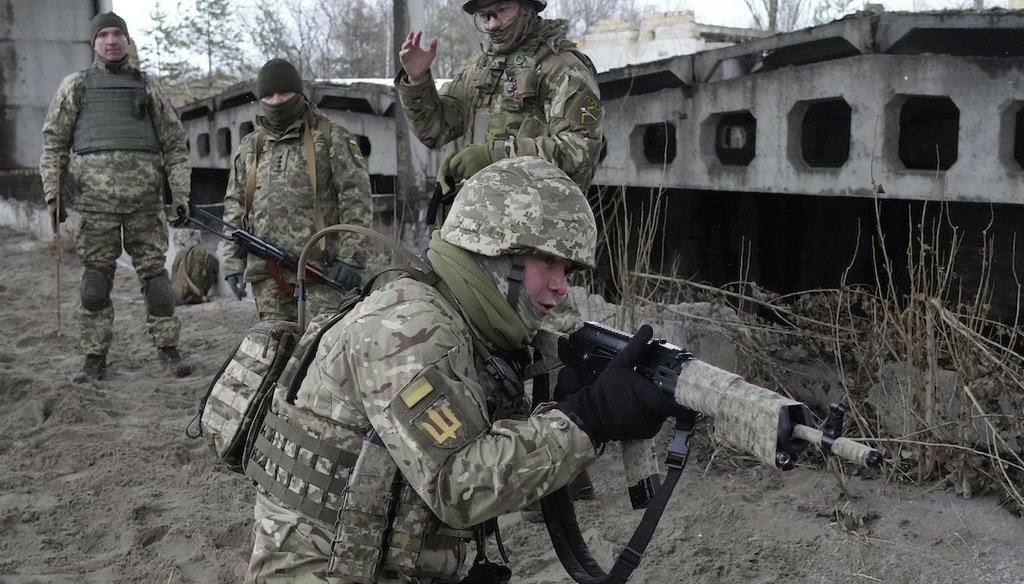Stand up for the facts!
Our only agenda is to publish the truth so you can be an informed participant in democracy.
We need your help.
I would like to contribute

Members of Ukraine's Territorial Defense Forces, volunteer units of the Armed Forces, train close to Kyiv, Jan. 29, 2022. Dozens of civilians have been joining Ukraine's army reserves in recent weeks amid fears about Russian invasion. (AP)
After Russia amassed troops and weapons along its border with Ukraine, the U.S. State Department last week ordered family members of staff working in its embassy in Kyiv to get out of the country, and also urged all U.S. citizens to leave.
In a stark warning, the department said U.S. citizens should leave the country now via commercial flights or other private transportation, saying that it may not be in a position to help them get out should Russian troops invade and conditions deteriorate.
"U.S. citizens in Ukraine should be aware that Russian military action anywhere in Ukraine would severely impact the U.S. Embassy’s ability to provide consular services, including assistance to U.S. citizens in departing Ukraine," reads the State Department’s travel advisory.
That statement prompted many on social media to compare the situation to the chaotic U.S. withdrawal of citizens from Afghanistan, suggesting Americans will be on their own in Ukraine.
In response to Fox News reporter Jennifer Griffin’s Jan. 23 tweet about the State Department’s warning, the conservative group Young America’s Foundation wrote: "Where have we seen this before?"
Where have we seen this before? https://t.co/taM1dpwcXq
— YAF (@yaf) January 24, 2022
On Jan. 25, the group followed with a Facebook post featuring a screenshot of its tweet and the caption "Incredible that Biden didn't learn from his mistakes with Afghanistan."
But that’s not an apt comparison. While some see similarities in the discussion of evacuating Americans, "there is no resemblance between the two", said Barnett Rubin, a senior fellow at New York University’s Center on International Cooperation.
There were tens of thousands of U.S. citizens in Afghanistan, because "the U.S. had been running a joint military-civilian operation there for 20 years, directed against the Taliban, who then took over," said Rubin. There are likely far fewer Americans in Ukraine, Rubin said.
"There are U.S. citizens in Ukraine for a variety of reasons, as there are U.S. citizens in most countries, for business, employment, tourism, family visits, etc. but they are not part of any U.S. government operation, certainly not part of a U.S. war against Russia," he added.
Large-scale military-run evacuations of U.S. citizens are not standard practice, White House Press Secretary Jen Psaki said at a Jan. 24 news briefing.
"There is not an intention for there to be a departure or an evacuation along those lines, so we are conveying to American citizens they should leave now," she said. "And, in fact, there is not precedent, beyond Afghanistan, for that to be how it operates."
The warnings to leave now certainly don’t rule out the State Department and military stepping in later to help Amercians in Ukraine, should the need arise. In 2006, the U.S. began a large-scale evacuation of citizens from Lebanon amid a battle between Israeli and Hezbollah, and the military has stepped in on many other occasions.
In Afghanistan, President Biden announced in April that the U.S. would withdraw troops from the country by September, ending a 20-year war that began shortly after the Sept. 11, 2001, terrorist attacks by al-Qaida. (The Trump administration had planned an earlier pullout.)
The U.S. as early as April began urging U.S. citizens to leave Afghanistan. At the time Biden downplayed the capability of the Taliban to regain control of the country. However, Taliban fighters swiftly recaptured government-controlled territory, encountering little resistance from Afghan security forces and taking control of Kabul by mid-August.
That left the U.S. scrambling to shut down its embassy and evacuate U.S. citizens and Afghans who feared reprisals from the Taliban for helping the U.S. during the war.
Chaotic scenes unfolded at the Kabul airport in August as the U.S. began one of the largest military evacuations in history. Eventually the U.S. flew 120,000 people, including about 6,000 American citizens, out of the country on military and private flights in the final six weeks before ending operations there on Aug. 30.
Russia in recent months has built up about 100,000 troops along Ukraine’s border but it doesn’t have troops inside the country, outside of two breakaway provinces in eastern Ukraine, the New York Times reports.
Russia’s motivation is unclear, but it could be an effort to reestablish some control over its neighbors that it lost during the Cold War.
The Pentagon this week ordered 8,500 troops on higher alert to potentially deploy to Eastern Europe as part of a NATO response force, and Biden warned that an invasion by Russia could happen at any time.
Ukraine officials weren’t happy with the U.S. decision to order family members of embassy staff to leave. It was "premature" and "an instance of excessive caution," Oleg Nikolenko, spokesman for the Ukrainian Foreign Ministry, said in a tweet. He said that only a handful of the 129 diplomatic missions in Ukraine are following the lead of the U.S.
Ukraine President Volodymyr Zelenskiy also urged calm, telling residents in a video address that Russia’s invasion actually began in 2014 when the country annexed Crimea, the Guardian reported. He accused U.S. officials and media of creating panic by suggesting war is imminent.
U.S. officials are concerned that if an invasion happens, their options to help Americans would become limited.
For U.S. embassies, getting as many Americans as possible to leave on commercial flights out of a dangerous situation "is the textbook standard for evacuations," said Joseph DeThomas, a professor at Penn State’s School of International Affairs and a former ambassador to Estonia who spent more than 30 years in the State Department.
It’s better, and cheaper for the evacuees, and gives them more control over where they are going and with whom, he said.
"It also means people are leaving before things get really hairy and inevitably more chaotic," said DeThomas, who added that if the situation were to devolve into a military evacuation like in Afghanistan, it "can be much smaller and limited to absolutely essential personnel who are paid to be at risk."
A State Department spokesperson told PolitiFact it was urging people to leave Ukraine now "out of an abundance of caution" because security conditions "are unpredictable and can deteriorate with little notice" and that the U.S. government will not be in a position to evacuate them later.
"Regularly scheduled commercial transportation is always the best option when local communications and transportation infrastructure are intact and operating normally," the spokesperson said, adding that if commercial flights become unavailable, leaving by car, bus or train to Poland, Slovakia, Hungary, Moldova and Romania could be an option.
Citizens should research airlines’ and countries’ COVID-19 testing and vaccination requirements first. Information is available on embassy websites.
A key difference between Ukraine now and Afghanistan in August is the conditions on the ground. Simply put, in Afghanistan, it was far too late for the kind of early warning that the U.S. is issuing now. Security conditions had already deteriorated as the Taliban entered Kabul, so even waiting for a government evacuation flight was risky, said Michael O’Hanlon, a senior fellow and director of research in Foreign Policy at the Brookings Institution.
"We got lucky because the Taliban chose not to oppose them," he said.
In Ukraine, life so far is pretty much going on as normal, despite tensions over Russia’s intentions, according to news reports.
People looking to leave Ukraine now wouldn’t face the hurdles people looking to flee Afghanistan did in August. There are no Taliban checkpoints to go through and no threats of terrorist attacks or violence that would be directed at Americans. There were more than 80 commercial flights out of Ukraine available on Jan. 28, according to flightstats.com, and people can leave by car or train to surrounding countries.
In Afghanistan, getting out of the country was complicated by the sheer number of people, and not just U.S. citizens, trying to leave amid the rapid takeover by the Taliban.
It’s not clear how many U.S. citizens are currently in Ukraine.
"U.S. citizens are not required to register their travel to a foreign country with us, and we do not maintain comprehensive lists of U.S. citizens residing overseas," a senior State Department official said, declining to give a total in a news briefing on Jan. 23.
However, senior State Department official Victoria Nuland told CNN’s Jake Tapper in December that there were about 10,000 to 15,000 Americans there, a number that fluctuates around the holidays.
PolitiFact researcher Caryn Baird contributed to this report.
Our Sources
Email interview with State Department spokesperson, Jan. 28, 2022
Email interview with Joseph DeThomas, a professor at Penn State’s School of International Affairs, Jan. 27, 2022
Email interview with Barnett Rubin, a senior fellow at New York University’s Center on International Cooperation, Jan. 27, 2022
Email interview with Michael O’Hanlon, a senior fellow and director of research in Foreign Policy at the Brookings Institution
The New York Times, "How Russia’s Military Is Positioned to Threaten Ukraine," Jan. 7, 2022
The New York Times, "U.S. Orders Family Members of Embassy Staff to Leave Ukraine," Jan. 23, 2022
The New York Times, "Large-Scale Evacuations From Lebanon Begin," July 19, 2006
Associated Press, "US draws down Ukraine embassy presence as war fears mount," Jan. 23, 2022
CNN, "Biden administration considering options for possibly evacuating US citizens from Ukraine if Russia invades," Dec. 7, 2021
The Washington Post, "These countries are withdrawing embassy staffers from Ukraine amid growing fears of an invasion by Russia," Jan. 25, 2022
The Washington Post, "The Afghan evacuation and the war — by the numbers," Sept. 2, 2021
State Department, "Ukraine Travel Advisory," Jan. 23, 2022
State Department, "Senior State Department Officials On Posture of U.S. Embassy Kyiv," Jan. 23, 2022
State Department, "What the Department of State Can and Can't Do in a Crisis"
U.S. Embassy in Ukraine, "Message to US Citizens: Commercial Air Availability from Ukraine," Jan. 26, 2022
U.S. Embassy in Afghanistan, "Security Alert U.S. Embassy Kabul, Afghanistan," August 7, 2021
U.S. Embassy in Afghanistan, "Afghanistan Travel Advisory – Level 4: Do Not Travel," April 27, 2021
White House, "Remarks by President Biden on the Way Forward in Afghanistan," April 14, 2022
U.S. Department of Defense, "Pentagon Press Secretary John Kirby Holds a Press Briefing," Jan. 24, 2022
Jennifer Griffin, Fox News reporter, tweet on Jan. 23
PolitiFact, "Fact-checking Joe Biden on U.S. credibility as military withdraws from Afghanistan," Aug. 26, 2021
PolitiFact, "Joe Biden’s full flop on messages about Afghanistan withdrawal," Aug. 20, 2021
The Wall Street Journal, "What Does Russia Want With Ukraine? Tensions Between Putin and NATO Explained," Jan. 27, 2022
The Guardian, "‘Life goes on’: Kyiv residents maintain calm amid threat of Russian invasion," Jan. 24, 2022
BBC News, "Viral videos, stoicism and stockpiling on Ukraine’s uneasy borders," Jan. 26, 2022
Oleg Nikolenko, spokesman for the Ukrainian Foreign Ministry, two tweets on Jan. 24
The Independent, YouTube, "Live: Ukraine president Volodymyr Zelensky speaks amid tensions with Russia," Jan. 28, 2022
White House, "Press Briefing by Press Secretary Jen Psaki, January 24, 2022," Jan. 24, 2022
U.S. Naval Institute News, "Afghanistan Exit Latest in Long History of U.S. Noncombatant Evacuation Missions," Aug. 17, 2021
























